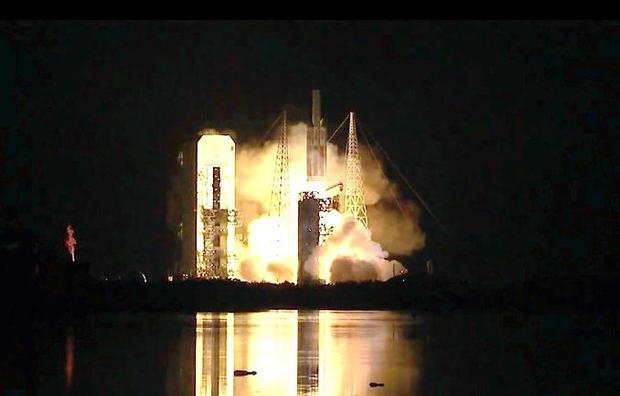After a string of frustrating delays, a United Launch Alliance Delta 4 Heavy rocket finally shot away from the newly renamed Cape Canaveral Space Force Station Thursday evening, lighting up the night sky for miles around as it boosted a top-secret National Reconnaissance spy satellite into space.
The three Aerojet Rocketdyne RS-68A engines powering the booster's triple-core first stage ignited with a burst of flame at 8:09 p.m. EST, three-and-a-half months after a dramatic last-second abort on August 29 that was blamed on trouble with ground equipment.
More trouble with the Delta's launch pad then was discovered, triggering additional delays, but the countdown finally reached zero Thursday and the heavy-lift booster roared away from pad 37 at the military launch complex.
Known for decades as the Cape Canaveral Air Force Station, the base was renamed earlier this week by Vice President Mike Pence in a ceremony that also included nearby Patrick Air Force — now Space Force — Base. The two installations are among the first to be renamed in the transition to U.S. Space Force operations.
As usual with a Delta 4 Heavy launch, orange flames billowed up from the base of the rocket as free hydrogen gas ignited in the fury of engine ignition. But the flames quickly dissipated as the 233-foot-tall booster accelerated skyward, arcing away to the east over the Atlantic Ocean.
Less than a minute-and-a-half later, the big Delta 4 raced through the speed of sound and on through the zone of maximum aerodynamic pressure as it climbed out of the thick lower atmosphere.
The rocket's two side boosters shut down and fell away as planned about four minutes after liftoff with the central common booster core following suit about a minute and a half later. The Delta 4's second stage RL10 engine, also built by Aerojet Rocketdyne, took over at that point to continue the push to orbit.
United Launch Alliance ended its webcast and ascent commentary moments after the second stage engine ignited and the rest of the flight was carried out in public silence, standard procedure for classified missions. No details about the satellite payload were released.
Ted Molczan, a respected independent satellite analyst, said the due east trajectory, the use of a powerful Delta 4 Heavy rocket and the timing of the flight suggested a heavy-weight signals intelligence satellite reportedly featuring a huge deployable antenna the size of a football field.
In any case, it was the 41st launch of a Delta 4 since the rocket's debut in 2002 and the 12th flight of the Heavy variant. Only four more Heavies remain in ULA's inventory as the company transitions to new, lower-cost Vulcan rockets that eventually will replace both the Delta 4 and ULA's Atlas 5 rockets.
The Delta 4 Heavy originally was scheduled for takeoff August 26, but launch slipped one day at the request of the NRO. An attempt on August 27 was called off due to a launch pad pneumatics issue than then more trouble with ground equipment triggered a last-second abort on August 29.
After that issue was corrected, engineers ran into problems with the system used to retract gantry access arms from the rocket during launch, then again with bad weather and more pad problems. But on Thursday, the countdown finally made it all the way to zero and the rocket blasted off in spectacular fashion.
Article From & Read More ( After string of delays, Delta 4 rocket launches classified spy satellite - CBS News )https://ift.tt/37TJESz
Science

No comments:
Post a Comment